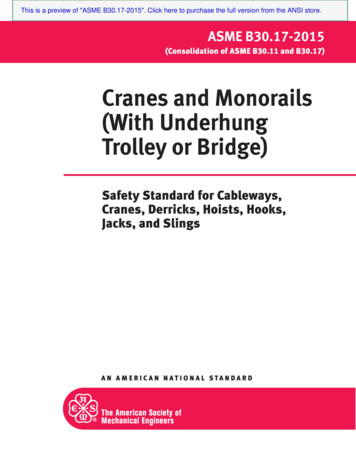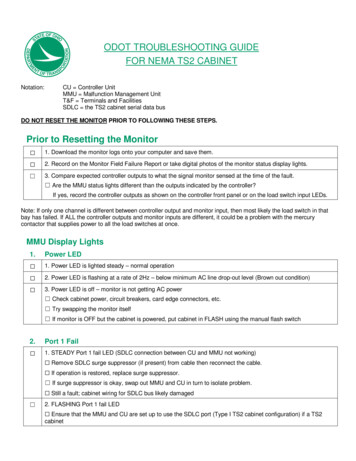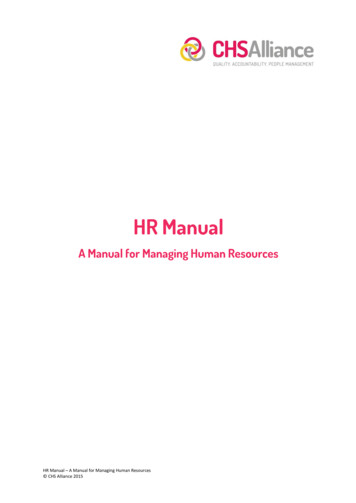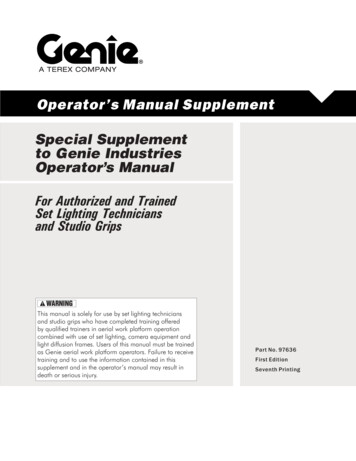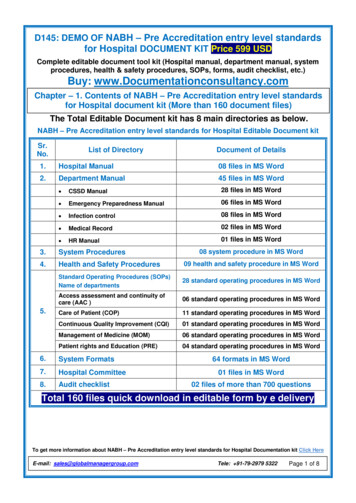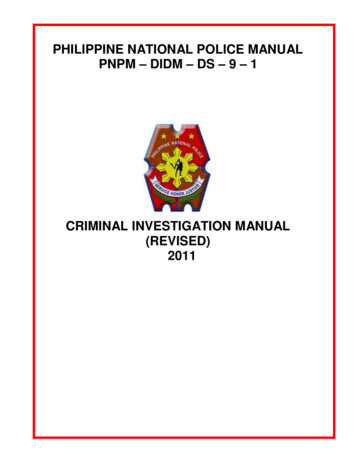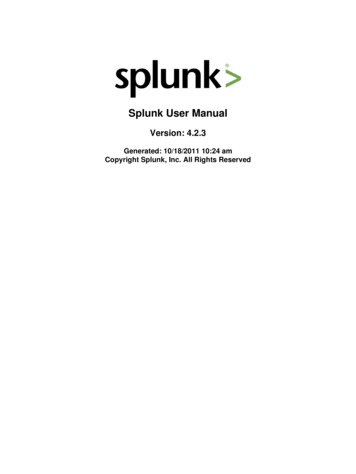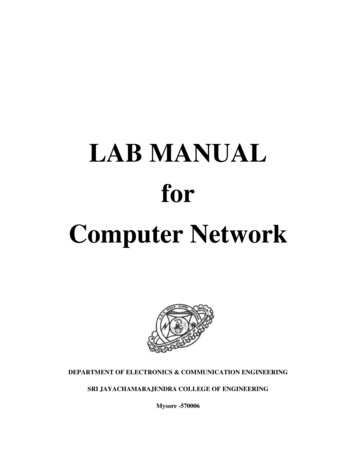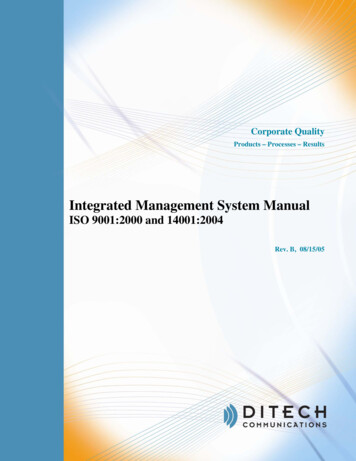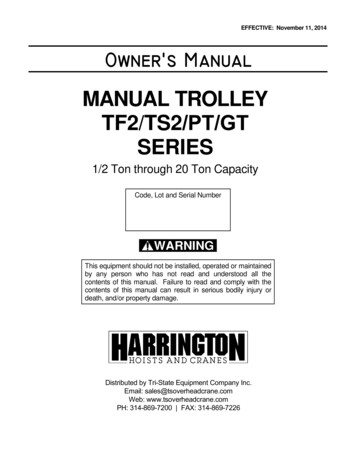
Transcription
EFFECTIVE: November 11, 2014 MANUAL TROLLEYTF2/TS2/PT/GTSERIES1/2 Ton through 20 Ton CapacityCode, Lot and Serial Number This equipment should not be installed, operated or maintainedby any person who has not read and understood all thecontents of this manual. Failure to read and comply with thecontents of this manual can result in serious bodily injury ordeath, and/or property damage.Distributed by Tri-State Equipment Company Inc.Email: sales@tsoverheadcrane.comWeb: www.tsoverheadcrane.comPH: 314-869-7200 FAX: 314-869-7226
Table of ContentsSection1.02.03.04.05.0Page NumberImportant Information and Warnings . 41.1Terms and Summary1.2Warning Tags and LabelsTechnical Information . 82.1Specifications2.2Dimensions2.3Optional EquipmentPre-operational Procedures .183.1Manual Hoist Adjustment for Trolley3.2Electric Hoist Adjustment for Trolley3.3Air Power Hoist Adjustment for Trolley3.4Trolley Assembly3.5Mounting Location3.6Installation of Trolley onto Beam3.7Electrical/Air Connections3.8Pre-operational Checks and Trial OperationOperation 504.1Introduction4.2Shall’s and Shall Not’s for Operation4.3Trolley ControlsInspection 535.1General5.2Inspection Classification5.3Frequent Inspection2
Section6.0Page Number5.4Periodic Inspection5.5Occasionally Used Trolleys5.6Inspection Records5.7Inspection Methods and CriteriaMaintenance & Handling .596.1Lubrication6.2Storage6.3Outdoor Installation7.0Warranty .608.0Parts List .618.1TF2 Push Trolley Parts – 1/8 to 5 Ton8.2TF2 Geared Trolley Parts – 1/8 to 5 Ton8.3TS2 Push Trolley Parts – 1/8 to 5 Ton8.4TS2 Geared Trolley Parts – 1/8 to 5 Ton8.5TF/TS Push/Geared Trolley Parts for CB Hoist – 8 to 10 Ton8.6TF/TS Push/Geared Trolley Parts for ER2 Hoist – 8 to 10 Ton8.7TF/TS Geared Trolley Parts for CB Hoist – 15 to 20 Ton8.8TF/TS Geared Trolley Parts for ER2f Hoist – 15 to 20 Ton3
1.0Important Information and Warnings1.1Terms and SummaryThis manual provides important information for personnel involved with the installation, operation and maintenance of thisproduct. Although you may be familiar with this or similar equipment, it is strongly recommended that you read this manualbefore installing, operating or maintaining the product.Danger, Warning, Caution and Notice - Throughout this manual there are steps and procedures that can present hazardoussituations. The following signal words are used to identify the degree or level of hazard seriousness. Danger indicates an imminently hazardous situation which, if not avoided, will result in death or seriousinjury, and property damage.Warning indicates an imminently hazardous situation which, if not avoided, could result in death or seriousinjury, and property damage.Caution indicates a potentially hazardous situation which, if not avoided, may result minor or moderateinjury or property damage.Notice is used to notify people of installation, operation, or maintenance information which is important butnot directly hazard-related. These general instructions deal with the normal installation, operation, and maintenance situations encountered withthe equipment described herein. The instructions should not be interpreted to anticipate every possible contingencyor to anticipate the final system, crane, or configuration that uses this equipment. For systems using the equipmentcovered by this manual, the supplier and owner of the system are responsible for the system’s compliance with allapplicable industry standards, and with all applicable federal, state and local regulations/codes.This manual includes instructions and parts information for a variety of trolley and hoist types. Therefore, allinstructions and parts information may not apply to any one type or size of specific trolley or hoist. Disregard thoseportions of the instructions that do not apply.Record your trolley’s Code, Lot and Serial Number on the front cover of this manual for identification and futurereference to avoid referring to the wrong manual for information or instructions on installation, operation, inspection,maintenance, or parts.Use only Harrington authorized replacement parts in the service and maintenance of this trolley.4
Equipment described herein is not designed for and MUST NOT be used for lifting, supporting, or transporting people,or for lifting or supporting loads over people.Equipment described herein should not be used in conjunction with other equipment unless necessary and/orrequired safety devices applicable to the system, crane, or application are installed by the system designer, systemmanufacturer, crane manufacturer, installer, or user.Modifications to upgrade, rerate, or otherwise alter this equipment shall be authorized only by the original equipmentmanufacturer.Equipment described herein may be used in the design and manufacture of cranes or monorails. Additionalequipment or devices may be required for the crane and monorail to comply with applicable crane design and safetystandards. The crane designer, crane manufacturer, or user is responsible to furnish these additional items forcompliance. Refer to ANSI/ASME B30.17, “Safety Standard for Top-Running Single Girder Cranes”; ANSI/ASMEB30.2 “Safety Standard for Top-Running Double-Girder Cranes”; and ANSI/ASME B30.11 “Safety Standard forUnderhung Cranes and Monorails”.If a below-the-hook lifting device or sling is used with a hoist, refer to ANSI/ASME B30.9, “Safety Standard for Slings”or ANSI/ASME B30.20, “Safety Standard for Below-the-Hook Lifting Devices”.Hoists, trolleys and cranes, used to handle hot molten material may require additional equipment or devices. Refer toANSI Z241.2, “Safety Requirements for Melting and Pouring of Metals in the Metalcasting Industry”.Electrical equipment described herein is designed and built in compliance with Harrington's interpretation ofANSI/NFPA 70, “National Electrical Code”. The system designer, system manufacturer, crane designer, cranemanufacturer, installer, or user is responsible to assure that the installation and associated wiring of these electricalcomponents is in compliance with ANSI/NFPA 70, and all applicable Federal, State and Local Codes.Failure to read and comply with any one of the limitations noted herein can result in serious bodily injury or death,and/or property damage.5
HAZARDOUS VOLTAGES ARE PRESENT IN THE HOIST CONTROL BOX, OTHER ELECTRICALCOMPONENTS, AND CONNECTIONS BETWEEN THESE COMPONENTS.Before performing ANY mechanical or electrical maintenance on the equipment, de-energize (disconnect) the mainswitch supplying power to the equipment; and lock and tag the main switch in the de-energized position. Refer toANSI Z244.1, “Personnel Protection – Lockout/Tagout of Energy Sources”.Only trained and competent personnel should inspect and repair this equipment. It is the responsibility of the owner/user to install, inspect, test, maintain, and operate a trolley or hoist in accordancewith ANSI/ASME B30.16, “Safety Standard for Overhead Hoists”, OSHA Regulations and ANSI/NFPA 70, "NationalElectric Code". If the trolley is installed as part of a total lifting system, such as an overhead crane or monorail, it isalso the responsibility of the owner/user to comply with the applicable ANSI/ASME B30 volume that addresses thattype of equipment.It is the responsibility of the owner/user to have all personnel that will install, inspect, test, maintain, and operate ahoist read the contents of this manual and applicable portions of ANSI/ASME B30.16, “Safety Standard for OverheadHoists”, OSHA Regulations and ANSI/NFPA 70, “National Electric Code”. If the trolley is installed as part of a totallifting system, such as an overhead crane, the applicable ANSI/ASME B30 volume that addresses that type ofequipment must also be read by all personnel.If the trolley owner/user requires additional information, or if any information in the manual is not clear, contactHarrington or the distributor of the trolley. Do not install, inspect, test, maintain, or operate this trolley unless thisinformation is fully understood.A regular schedule of inspection of the trolley in accordance with the requirements of ANSI/ASME B30.16 should beestablished and records maintained.6
1.2Warning Tag and LabelsThe warning tag illustrated below in Figure 1-1 is supplied with each trolley shipped from the factory. If the tag is not attached tothe pendant cord for your hoist/trolley, order a tag from your dealer and install it. Read and obey all warnings attached to thistrolley. Tag is not shown actual size.EnglishEnglishSpanishSpanishWarning Tag for Harrington powered productsWarning Tags for Harrington Manual Chain productsFigure 1-1 Warning Tag Attached to Trolley7
2.0Technical Information2.1Specifications2.1.1Product Code for TF2 Trolley:2.1.2Product Code for TS2 Trolley:2.1.3Operating Conditions and EnvironmentTemperature Range:Humidity:-4 to 104 F (-20 to 40 C)85% or less8
2.1.4PTF2 SpecificationsTable 2-1 PTF2 Trolley forCurve(in)StandardOptionFlange Width AdjustabilityB(in)Approx. NetWeight(lbs)1/2PTF200513.82.28 to 4.004.01 to 8.00or8.01 to 12.0091PTF201017.72.28 to 5.005.01 to 8.00or8.01 to 12.00151 1/2-2PTF202021.73.23 to 6.026.03 to 12.00292 1/2-3PTF203025.6465PTF205078.74.92 to 7.027.03 to 12.00958PTF080118.15.50 to 8.668.67 to 12.0021210PTF100PTS2 SpecificationsTable 2-2 PTS2 Trolley rve(in)Flange Width AdjustabilityB(in)Approx. NetWeight(lbs)StandardOption10181/2PTS200543.32.28 to 4.004.01 to 8.00or8.01 to 12.001PTS201051.22.28 to 5.005.01 to 8.00or8.01 to 12.001 1/2-2PTS202059.13.23 to 6.026.03 to 12.002 1/2-3PTS203066.95PTS205090.63.94 to 7.027.03 to 12.001108PTS080118.15.50 to 8.668.67 to 12.0022010PTS10031519
2.1.6GTF2 SpecificationsTable 2-3 GTF2 Trolley SpecificationsCap.(Tons)Product CodeMin.RadiusforCurve(in)StandardOption2.28 to 5.005.01 to 8.00or8.01 to 12.003.23 to 6.026.03 to 12.001GTF201017.71 1/2-2GTF202021.72 020GTF200Flange Width AdjustabilityB(in)ER2CB2438554.92 to 7.027.03 to 12.00118.15.50 to 8.662.1.7Approx. NetWeight(lbs)1042482184905348.67 to 12.00 GTS2 SpecificationsTable 2-4 GTS2 Trolley SpecificationsCap. ion2.28 to 5.005.01 to 8.00or8.01 to 12.003.23 to 6.026.03 to 12.001GTS201051.21 1/2-2GTS202059.12 020GTS200Flange Width AdjustabilityB(in)Approx. NetWeight(lbs)ER2CB2742603.94 to 7.027.03 to 12.00118.15.50 to 8.66 101242572275105538.67 to 12.00
2.2Dimensions2.2.1PTF2 DimensionsTable 2-5 PTF2 Trolley DimensionsPTF2005 to TF2050 to 31.5B-1.80.873.71.11PTF20108.59.89.32.24.22.801 90.984.24.43.85.22.4B-2.31.265.12 .0B-3.62.764.71.410-PTF10011
2.2.2PTS2 DimensionsTable 2-6 PTS2 Trolley DimensionsPTS2005 to 2050 to 3.14.42.0B-1.90.984.21 -2.31.265.12 5.97.76.0B-3.62.764.710PTS10012
2.2.3GTF2 DimensionsTable 2-7 GTF2 Trolley DimensionsGTF2010 to GTF2030GTF2050 to GTF2100GTF2150 to 1 1/2-2GTF202013.715.211.06.12 n)k(in)k'(in)CB87.2r(in)s(in)t(in)u(in)v(in)ER2 CB4.22.801.13.74.22.24.42.0 B-1.8 0.985.03.351.34.44.32.85.22.4 B-1.9 .53.47.76.026.4 17.4 31.3 22.2 18.916.2n(in)127.341.0 23.0 24.3 24.3 39.46.10-5.46.7*This dimension is variable on15/20 Ton model, therefore it is recorded at its maximum value for standard range.8.07.22.13B-3.6 2.7618.0 8.9 28.213B-2.31.424.25.16.73.78.44.6
2.2.4GTS2 DimensionsTable 2-8 GTS2 Trolley DimensionsGTS2010 to GTS2030GTS2050 to GTS2100GTS2150 to in)ER2b(in)CBe(in)f(ft.)h(in)i(in)ER2 CB1/2-1GTS201010.813.69.36.01 1/2-2GTS202013.715.211.06.12 8GTS08010GTS10015GTS15020GTS200m(in)jkk'(in) (in) (in)41.0s(in)t(in)u(in)v(in)ER2 CB4.22.80 1.1 3.7 4.22.24.4 2.0 B-1.80.984.25.03.35 1.3 4.4 4.32.85.2 2.4 B-1.91.265.111.05.83.94 1.4 5.3 4.53.16.0 2.71.4211.46.74.65 1.8 5.7 5.23.27.0 3.53.47.7 6.010.526.4 17.4 31.3 22.2 19.416.2 7.2nr(in) (in)127.323.0 24.3 24.3 39.86.10-5.4 6.7B-3.618.0 8.9 28.2 8.0*This dimension is variable on15/20 Ton model, therefore it is recorded at its maximum value for standard range.14B-2.37.26.72.133.72.76 8.44.6
2.3Optional Equipment2.3.1Suspender CTable 2-9 Suspender C 2.721.31.60.91.272.73.22 .42.135.56.1Suspender HTable 2-10 Suspender H )1/4-1/21.01.30.40.912.311.11.50.51.022.61 1/2-21.41.80.71.303.32 1/2-3
with ANSI/ASME B30.16, “Safety Standard for Overhead Hoists”, OSHA Regulations and ANSI/NFPA 70, "National Electric Code". If the trolley is installed as part of a total lifting system, such as an overhead crane or monorail, it is also the responsibility of the owner/user to comply with the applicable ANSI/ASME B30 volume that addresses that type of equipment. It is the responsibility of .
